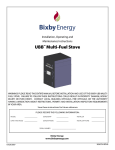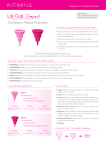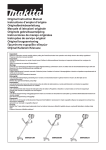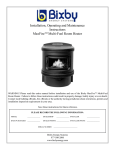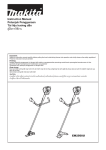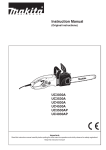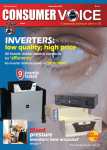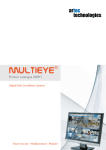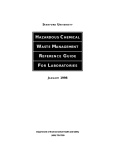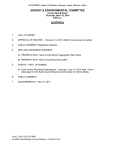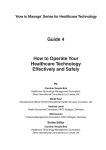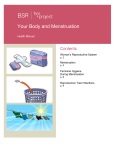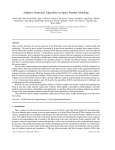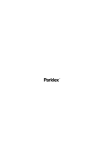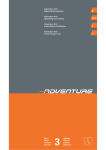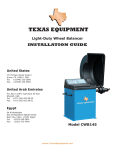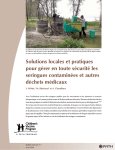Download Safe Handling of Health Care Waste
Transcript
Safe Handling of Health Care Waste A selection from Hesperian Foundation’s forthcoming Community Guide to Environmental Health The Hesperian Foundation is a non-profit organization committed to building a more just world by producing health education materials that enable communities and individuals to take the lead in their own health care. As co-conveners of the U.S. Circle of the People’s Health Movement, we demand “Health for All, NOW!” Contact us at: Hesperian Foundation 1919 Addison St., #304 Berkeley, California, 94704 USA tel: 510-845-4507 fax: 510-845-0539 email: [email protected] website: www.hesperian.org Copyright © 2005 by Hesperian Foundation The Hesperian Foundation encourages others to copy, reproduce, or adapt to meet local needs any or all of this pamphlet provided that what is reproduced is distributed free or at cost — not for profit. Please contact the Hesperian Foundation before beginning any reproduction, adaptation, or translation to avoid duplication of efforts and to make sure you are working with the most recent, updated version of these materials. Safe handling of health care waste Page Health care waste can cause health problems ................................ 3 The most common health problems caused by health care waste ....... 4 The problem of incineration ............................................................... 5 Sangu’s story .................................................................................... 6 Preventing harm from health care waste ....................................... 8 Reducing waste ................................................................................. 9 Separating waste ............................................................................... 9 Separating with colored containers ........................................... 10 Storing and transporting waste ....................................................... 11 Protect yourself and others when handling waste ............................ 11 Disinfecting waste ......................................................................... 12 What wastes need to be disinfected? ......................................... 12 Disinfecting with chemicals .......................................................... 13 Disinfecting with bleach ............................................................ 14 How to use a bleach bucket ...................................................... 15 Disinfecting with safe chemicals ............................................... 15 Disinfecting with heat ................................................................... 16 Boiling ..................................................................................... 16 Steaming .................................................................................. 16 Pressure steaming .................................................................... 16 Autoclave ................................................................................. 17 Microwave ................................................................................ 17 Sharps treatment and disposal ...................................................... 18 Guide to infectious waste treatment and disposal ....................... 20 Burying health care waste ............................................................. 21 Safe waste pits ......................................................................... 21 Disposing of liquid waste ........................................................... 22 Vaccination programs and their waste ...................................... 23 Safe disposal of chemical wastes................................................... 24 Disposing of chemicals used to clean and disinfect .......................... 24 Mercury .......................................................................................... 25 Antibiotics and other medicines ....................................................... 26 Education for Action: Organizing a health care waste assessment.. 27 Community-based solutions ............................................................ 30 Health care waste and the law ......................................................... 31 List of difficult words ....................................................................... 32 Safe handling of health care waste HEALTH CARE WASTE CAN CAUSE HEALTH PROBLEMS Health workers in every clinic, hospital, and home do their best to help people heal. But if waste from health care is not handled and treated safely, it can create health problems for the health workers and the surrounding community. Health care waste includes waste from clinics, hospitals, laboratories, blood banks, dental clinics, birth centers and animal hospitals. It also includes waste from vaccination programs and medical aid missions, and waste produced when caring for the ill at home. Some health care waste is contaminated with blood or body fluids that may carry harmful germs and spread disease. Used needles and other sharp tools can cause injury as well as spread disease. And some health care waste contains dangerous chemicals that can poison the water, soil, and air. If these chemicals get into our bodies, they can poison us or cause cancer. Most waste from health care is ordinary waste like paper, cardboard, and food scraps. But when waste that carries harmful germs or dangerous chemicals is mixed with ordinary waste, the mixed waste becomes a threat to all who handle it, both inside and outside of the health center. This chapter includes information about how to assess the health care waste problems in your center or community. It also offers some ideas about how to reduce the amount of dangerous waste created by health care. Since it is impossible to completely eliminate health care waste, it is important to know: • how to separate different kinds of waste • how to disinfect waste that carries germs • how to safely dispose of small amounts of chemicals • how to protect yourself and others from sharps • how to safely bury waste that cannot be treated any other way This chapter does not include information about waste from x-rays, chemotherapy, and medical laboratories because these wastes need treatment that is more complicated than we can describe here. Please see the resources listed at the end of the chapter for more information. A Community Guide to Environmental Health 4 The most common health problems caused by health care waste • • • • Wounds from dirty needles, sharp instruments, and other sharps can cause many illnesses, including: Hepatitis B and C, tetanus, HIV/AIDS, staph infections, and other infections. Frequent contact with disinfectants, detergents, medicines, and laboratory chemicals can cause allergies, skin rashes, eye irritations, asthma and other breathing difficulties, and other reactions. Frequent contact with discarded antibiotics can cause antibiotic resistance, making these drugs less useful in fighting infections. Burning health care waste can release dangerous metals such as mercury, lead, and cadmium as well as toxic chemicals such as dioxins into the environment. These can cause cancers and many health problems. People most at risk of harm from health care waste are: • workers and patients in health centers, especially workers who collect and move the trash. • people who live near where health care waste is dumped or burned • people who collect, recycle, or sell trash from dump sites and landfills Safe Handling of Health Care Waste 5 The problem of incineration In order to destroy health care waste and the germs it carries, many clinics and hospitals burn it in furnaces called incinerators. It is easy to burn health care waste, because different kinds of waste can be collected and simply thrown in the incinerator. But incineration does not completely destroy the waste. Health care waste incinerators release chemicals into the air as smoke, and into the soil and ground water as ashes. When health care waste containing mercury, lead and other metals is burned, poisonous forms of these are released into the environment. When plastics such as blood bags, syringes, and tubes are burned, they produce very dangerous chemicals called dioxins and furans. These chemicals have no color and no odor, and cause cancer, reproductive harm, and other serious health problems. Incinerating health care waste releases toxic chemicals into the air, soil, and groundwater. Often incinerators do not burn hot enough or long enough to burn waste completely. Some incinerators are built to handle specific wastes, such as vaccination wastes, but end up being used for other wastes as well. In some cases health care waste incinerators are used to burn medicines, pesticides, and other dangerous chemicals. Burning waste creates more problems than it solves. The rest of this chapter describes ways to deal with waste so that it does not have to be burned. We recommend separating out waste that is not harmful — such as paper, cardboard, and uninfected plastic and metal — so that it can be recycled or reused, and disinfecting waste that carries harmful germs. Recycling waste materials can bring money to the centers. We recommend burying waste safely if it cannot be treated any other way. By using safe alternatives to incineration, the health workers’ oath “do no harm” can be applied even to the difficult task of waste disposal. 6 A Community Guide to Environmental Health Sangu’s story When Sangu was young she lived in a small village. After years of drought, she and her mother and baby brother moved to the city in search of a better life. They lived with her mother’s family on a steep hill over a dump site. Other children showed Sangu how to beat off stray dogs and pick out things to sell at the dump site. Before school every morning she went to the dump site to collect scraps of tin, glass bottles, plastic bags, and other things. She used the money she made to buy lunch and hot tea after school. But life was hard in the city, and Sangu’s mother was soon working away from the house all day. Sangu had to take care of her baby brother and could no longer go to school. Every day she spent many hours sorting through garbage at the dump with her brother in a sling on her back. Sometimes Sangu found bloody bandages, needles, and other hospital waste all mixed in with the rest of the trash. Sangu’s thin sandals did not protect her from getting hurt by sharps buried in the trash. Broken glass and rusted metal would sometimes cut her ankles. One day a syringe needle pierced her sandal and went right into her foot. Soon after the needle pierced her foot, Sangu got very sick with fever, sore throat, tiredness and swollen lymph glands. Sangu felt better after some weeks, but a few months later she began to feel sick again. She was tired all the time, had fevers, and lost her appetite. She had loose stool and grew very thin. Her mother and family worried about her, but they had no money to take her to a doctor. Her mother borrowed money from a cousin and took Sangu to the health center. The doctor listened to Sangu’s story, examined her and then took a blood test. A few weeks later they returned to the clinic and the doctor told Sangu’s mother that Sangu had HIV/AIDS. Her illness was very grave, but her family had no money to take her to the hospital for treatment. In despair, Sangu’s mother took her home. Sangu rested in bed, but everyone knew she would not recover. A few months later, Sangu died. Safe Handling of Health Care Waste Why did Sangu die? Sangu died from HIV/AIDS after she was infected by stepping on a contaminated syringe needle in a pile of trash. Her illness and death were caused by an environmental problem — poor disposal of health care waste — and a social problem — poverty. What could have prevented Sangu’s death? Questioning the social problem: • • • • Why wasn’t Sangu in school? Why did Sangu need to collect waste from the dump site? Why didn’t Sangu have good shoes to protect her feet? Why wasn’t she able to get health care and medicine when she needed it? These questions are easy to answer, but the social problems related to poverty are very difficult to solve. Poor shoes, no money for medicine, and collecting harmful waste, combined with the malnutrition and other problems that accompany poverty, made Sangu’s chance to live a healthy life very slim. Questioning the environmental problem: • Why was harmful health care waste mixed in with other trash that could be recycled and used? • Why was so much harmful waste dumped in the open, rather than safely buried? The environmental questions may be harder to answer at first, but they are easier to solve. Responsible management of waste can make living conditions better for everyone, especially those forced by poverty to live on scraps. The rest of this chapter explains how to manage health care waste in a way that will protect people who work in health centers, as well as people like Sangu who collect and recycle waste beyond the walls of health centers. Health care waste affects many people, even those too poor to go to a health center. 7 A Community Guide to Environmental Health 8 PREVENTING HARM FROM HEALTH CARE WASTE Whether in a small health post, a larger clinic, or when doing health care in the home, medical tools and health care waste must be handled safely to prevent harm. Preventing harm from health care waste includes: choosing medical supplies carefully to reduce the quantity and harmfulness of the waste • separating wastes where they are created • disinfecting wastes that carry germs • treating chemical wastes to make them less harmful by diluting them with water or adding other chemicals • disposing of health care wastes in the least harmful way possible • safely transporting, storing, and removing waste • training everyone who handles health care waste about safe methods Preventing harm from health care waste depends on people. No matter which method your clinic, center or hospital decides to use, make sure that everyone who handles health care waste, especially new people, understands what needs to be done and why. Often people will bring up new ideas that can make work easier and safer for everyone. Some clinics have a team of people who together are responsible for training and monitoring safe practices. • Safe Handling of Health Care Waste 9 Reducing waste Many materials used in health care become waste. Using fewer materials, and less harmful materials, will reduce the amount of harmful waste. When choosing health care materials, think about what kind of waste will be produced, and how harmful it will be. Try our new disposable plastic sheet covers! Does our clinic really need this? To reduce the amount of harmful waste: • • • • • • Avoid using disposable items if a reusable version is available. (Some items such as syringes and needles should not be reused if possible. See page 19.) Use non-mercury thermometers if they are available. Do not over-buy antibiotics, and use them only when necessary. Use pills instead of injections. Use non-plastic items when possible. Use the least toxic products to clean and disinfect whenever possible. Separating waste The key to safe handling of waste in the health center is to separate waste at the place where it is created. Harmful waste can then be safely treated, stored and transported to where it can be treated, buried or recycled. Uncontaminated waste can be separated, recycled, and reused. Discarded food can be made into compost and used to improve soil and create a garden near the health center. Harmful waste can be safely disinfected and disposed of (see pages 12 to 20). This will greatly reduce risks to health center workers and people who collect, sell, and recycle waste. Separation also reduces the amount of waste that must be treated or buried later. It also reduces the cost of waste management. Compost from food waste can be used to fertilize a clinic garden — and provide food for the clinic kitchen. A Community Guide to Environmental Health 10 Separating with colored containers To make it easier for each kind of waste to get the right treatment, many health centers separate wastes into different colored containers at the places where waste is created. For this to work, everyone in the health center needs to understand how different kinds of waste are treated and disposed of, and what wastes go in what color containers. Different countries use different colors for each type of waste. For example, in some countries the color red is used to indicate danger. So containers for sharps and other harmful or dangerous wastes are marked with red paint, marker or tape. More than half of all waste from health centers is just like household waste: paper, cardboard, bottles, cans, and kitchen scraps. If regular waste is separated out, it is much easier to deal with the harmful waste. Regular waste should be put into bags and bins and recycled, composted or reused if possible. Harmful waste should be separated and treated carefully, (see chart on page 20). Containers should be: • strong enough that they do not leak or break. • big enough to hold a full day’s waste when only ¾ full. • placed close to where waste is created. • easy to seal and transport without risk of spills, leaks, or breaks. • clearly marked with colors and symbols. It is best to use containers and bags that are the same color for the same kind of waste. If this is not possible, mark them with colored tape or paint. This way, workers who do not read will understand which color container is for regular waste and which color is for harmful waste, and so on. Safe Handling of Health Care Waste 11 Storing and transporting waste Health care waste needs careful storage until it can be transported safely to its final disposal site. Waste containers should be placed where waste is created and disinfected — never in hallways, bathrooms, wash basins, or other places where people might spill them or fill them with mixed waste. Seal waste bins and bags when they are only ¾ full as a safety measure. The ¾ full bins and bags are less likely to spill or break, reducing the chances of injury to a worker picking up waste. If a bag breaks or leaks, put it inside another bag before moving it through the health center. Store the sealed bags in a closed room until they can be removed from the site. The room should be secure from scavenging and from animals. Health care waste can only be stored safely for specific amounts of time before it begins to smell bad and risk spreading infection as it decomposes: Moderate climate — 3 days in winter and 2 days in summer Warm climates — 2 days during cool season and 1 day during hot season After these times, waste must be treated or transported away from the center. Carts or trolleys which are easy to clean after each use and have no sharp edges that could damage bags or containers during loading or unloading are safest for transporting waste. Protect yourself and others when handling waste Workers in health centers, people who collect garbage, people who operate incinerators, and recyclers and scavengers are at the most risk of harm from health care waste. To prevent harm when handling waste: • • • • • Wear protective clothing to reduce risks from sharps, germs, or splashes from blood, other bloody fluids or chemicals. Never put needles or other sharps in bags with other waste. Wash hands after handling waste, and before and after working with every patient. Never carry open needles. Do not let waste touch your body. Safety glasses can protect eyes from any liquids that splash, or other things that may fly up. A facemask offers some protection from breathing in germs. Thick rubber gloves keep germs and chemicals off hands. An apron keeps germs off clothes. Clothes that cover the entire body keep chemicals and germs off skin. Rubber boots protect against accidents from sharps and spills. Protective clothing only works if it’s clean! After each use or at the end of each shift, wash gear such as gloves, aprons, glasses, and masks. This will prevent the next person that uses it from being contaminated. If your center does not have protective clothing, people can use available materials for protection. For example, many people use plastic garbage bags to make protective aprons, pants, masks and hats. It is better to have some protection than none at all! A Community Guide to Environmental Health 12 DISINFECTING WASTE Disinfection means destroying germs that cause infection. As much as possible, health care waste should be disinfected in the place where it is produced. The most common methods of waste disinfection used in health centers or in home health care practice are disinfection with chemicals (using chlorine bleach, hydrogen peroxide or other chemicals) and disinfection with heat (using boiling, steaming, pressure steaming, autoclave or microwave). This section shows how to disinfect waste so that it can be safely buried. Apart from re-usable syringes, this chapter does not show how to sterilize surgical tools or other materials that will be re-used. What is sterilizing and what is disinfecting? Some manuals about treating health care equipment and waste use the word sterilizing rather than disinfecting. Sterilizing and disinfecting are not the same and many people confuse them. Sterilizing means killing all of the germs on something. It is very difficult to do. Disinfecting means killing enough of the germs on something that so it will not transmit infection. Many people use the word sterilization for proper treatment of health care equipment, and the word disinfection when talking about cleaning floors and other surfaces with ‘disinfecting cleaners.’ But there are different levels of disinfection. The treatments described in this book are ‘high-level disinfection’ which means killing almost all the germs on something. For this reason, we use the word disinfection for all of the methods in this book. Any materials in a health center that are contaminated with blood, body fluids or feces, or that have been in close contact with a person with a contagious disease, will need to be disinfected to prevent the spread of infection and disease. (See pages 13 to 22 for ways to disinfect and dispose of wastes.) What wastes need to be disinfected? Wastes that need disinfection: Wastes that do not need disinfection: Used sharps Body parts Blood and body fluids Wastewater from disinfection and cleaning Bandages, swabs, and other wastes that carry body fluids Other items contaminated with blood, body fluids or feces Feces from people with infectious disease (such as cholera) Bedding from all people Chemicals from disinfection, cleaning and laboratory tests Food waste Feces from healthy people Any materials not contaminated with blood or body fluids(cardboard, paper, plastics, glass, metal) Safe Handling of Health Care Waste 13 Disinfecting with chemicals All chemicals used for disinfection can be harmful and need to be used with great care. Some chemicals commonly used for disinfection include hydrogen peroxide (6%), chlorine bleach, ethanol (70%), and isopropyl alcohol (70% to 90%). Many common cleaning and disinfecting products, such as Lysol, contain glutaraldehyde or formaldehyde. Regular exposure to glutaraldehyde and formaldehyde can cause cancer and death. These chemicals should not be used if possible. (See pages 14 and 15 for safer ways to disinfect with chemicals, and page 23 for safe disposal of chemicals.) No matter what chemicals you use in your health center, use them carefully. • • • • Wear gloves, safety glasses, a mask, and protective clothing to protect your skin, eyes and breathing when handling or disposing of chemicals. Keep disinfecting chemicals in their proper containers. Label the containers. Do not use those containers for anything else. Keep chemical containers tightly closed and stored upright. Check Chemical fumes can be harmful! them for breaks, leaks, and weak spots. Do not put chemicals in drink bottles, water buckets, or containers that may be used for food. Wastes best treated with chemicals Blood, other body fluids, and feces require chemical disinfection to prevent the spread of disease. These wastes can be separated in colored bags or containers, disinfected with bleach and then safely buried. Bedpans and bedding used by people with infectious diseases should also be disinfected with bleach and then washed with hot water and soap. The used bleach can be diluted in water and then poured in a leaching pit, sanitary sewer or septic tank. It is often thought that body parts need to be disinfected with chemicals. But body parts, including placentas (afterbirths) and umbilical cords, are most simply disposed of by putting them in a latrine or burying them deep in the ground. But in many communities, burying placentas is an important ritual. If it is done safely, burial is also a good way to protect the community from germs that may grow in the placenta or other body parts. (See pages 21 and 22 for safe methods of waste burial and leaching pits.) A Community Guide to Environmental Health 14 Disinfecting with safe chemicals Some health centers use products that contain harmful chemicals such as glutaraldehyde to disinfect and clean (see pages 13 and 23). But surfaces in health centers can be kept clean and germ-free by using less dangerous — and less costly — materials. This stuff is great! It kills everything. Including us! You can buy hydrogen peroxide solutions that contain orange oil and other natural oils that are strong and effective for disinfecting floors and surfaces. They do not cause health When choosing a product, ask these questions: problems and do not have to be treated Is it harmful? Is it difficult to dispose of safely? before disposal. Or you can make a safe disinfecting solution by mixing together equal parts of white vinegar and hydrogen peroxide. This is how to use it: 1. 2. Mix together only enough hydrogen peroxide and vinegar needed for one day. Keep it in a closed container. (A 3% peroxide solution is common, but 6% is better.) Pour a small amount of the mixture on a wiping cloth and scrub the surface to be disinfected with strong rubbing motion. This mixture is best for use on tabletops, bed railings, and other surfaces. Using hot water and soap to clean surfaces such as floors, walls and furniture is often a good first step in making your center germ-free. But in areas where people with infectious diseases wait or are treated, it is important to use a stronger disinfectant to prevent the spread of disease. Disinfecting with bleach Many health centers use bleach to disinfect surfaces such as walls, floors, and tables. But care must be taken when disinfecting with bleach because it can cause harm to your skin and eyes when splashed, and the fumes are dangerous to breath. One way to more safely disinfect with bleach is to use a bleach bucket. A bleach bucket has an outer container that holds the bleach solution, and a smaller inner container or basket with many small holes that will hold the wastes. Any metal or plastic bucket or container with a strainer or even a wicker basket placed inside will make a good bleach bucket. A bleach bucket must have a tight-fitting cover. To prepare a bleach bucket: 1. 2. Make a 5% bleach solution (see the box on page 15). The outer bucket should be at least ½ full of the bleach solution. Place the smaller container or basket inside the outer bucket so the bleach solution passes through the holes. Make sure the inner container does not float on top of the solution, but that the bleach solution passes though the holes so it will soak into the waste materials. Safe Handling of Health Care Waste 15 How to use a bleach bucket If possible, keep a bleach bucket wherever there is infectious waste such as used bandages, cotton swabs, gloves, and blood bags. Prepare the bleach bucket every day, or before each shift if you use a lot of materials. You may want to use one bleach bucket for disposable waste and a different one for disinfecting tools and equipment that will be reused. Cut all gloves, syringes, IV bottles, tubing, and other things that are not intended to be reused before dropping them in the bleach bucket. The bucket should always contain enough bleach to completely cover the materials. Materials should stay in bleach for at least 10 minutes. Keep a tight-fitting cover on the bleach bucket. This will prevent spills, and will also ensure that the bleach solution does not lose strength. How to make a disinfecting solution of 5% bleach Chlorine bleach from the store comes in different strengths. The strength of the bleach is shown by the amount of available chlorine it has. For this reason, you may have to mix it with water to make a disinfecting solution. If your bleach says: Use: 5% available chlorine………… just bleach. 10% available chlorine……… 15% available chlorine……… Add 1 part bleach to 1 part water Add 1 part bleach to 2 parts water bleach bleach bleach water water water Mix just enough solution for one day. Do not use it again the next day. It will not be strong enough to kill germs any more. To dispose of used bleach, see page 22. Bleach should never be mixed with other chemicals, especially ammonia. This mixture will produce a toxic gas that can cause death if breathed in, and enough heat to cause an explosion. Always wash carefully after handling bleach. Laundry In the past, many hospitals used carbolic acid to sterilize sheets. Now it is known that this is not necessary, except for burn victims. To disinfect bed linens and clothes, soak them in a bleach bucket for 10 minutes before washing with hot water and soap. A Community Guide to Environmental Health 16 Disinfecting with heat Many health centers use autoclaves or microwaves to disinfect syringes, tools, and some waste. If you have no autoclave or microwave, then boiling, steaming, or pressure steaming materials for at least 20 minutes will disinfect them. Waste should not be disinfected together with tools that will be reused because it will be difficult to separate the reusable tools from the waste in a way that keeps the tools clean. To ensure disinfection For boiling, steaming, and pressure steaming, start to count the 20 minutes after the water is fully boiling. Do not add anything new to the pot once you begin to count. After 20 minutes, turn off the heat and let it cool. Materials that will be reused after they are boiled or steamed must be removed using sterile gloves or tongs and placed right away inside a disinfected container, and then sealed. The used water can be safely poured down a drain because it has been disinfected. Boiling You can use boiling to disinfect metal, rubber or plastic tools, and cloth. After you wash and rinse the tools put them in the pot, cover the tools with water, and boil for 20 minutes. Steaming You can use steaming to disinfect gloves, masks, and things made of metal and plastic. The water does not need to cover everything in the pot — but you must use enough water to keep steam coming for 20 minutes. The pot should have a lid that fits tightly. Pressure steaming You can use pressure steaming to disinfect metal, rubber, plastic, and cloth. Wash and rinse the materials to be disinfected and put them in the pressure cooker with enough water to make steam for 20 minutes. Close the lid and heat it on the stove. After it comes to a boil, cook at 15 to 20 pounds of pressure for 20 minutes. Safe Handling of Health Care Waste 17 Autoclave An autoclave disinfects things using steam heat and pressure. Autoclaves have been used for many years to disinfect medical instruments. They are used more and more to treat waste as well. If your health center uses autoclaves to disinfect both instruments and waste, it is safest use 2 separate machines — one for reusable instruments and one for waste. For health centers with very small amounts of waste to be disinfected, a pressure steamer is less expensive and works as well as an autoclave. Most autoclaves need electricity to operate, but it is possible to build gas-fired, kerosene-fired, or solar-powered autoclaves for areas with no electricity. Microwave Microwaves create heat by contact with moisture in the objects placed inside them. It is the heat, together with the amount of time an object is microwaved, which leads to disinfection. Because microwave ovens vary greatly in their power, you should use care when disinfecting with this method. Many hospitals use large, high-powered microwaves to disinfect tools and waste. To ensure high-level disinfection: 1. 2. 3. 4. 5. Wear gloves and a mask to cut up plastic and cloth items such as catheters, IV bags, tubing, large bandages, and so on. Put the waste in a non-metal container with enough water to cover the waste. Put a light cover over the top of the container to reduce the loss of water during heating. Microwave waste materials for at least 20 minutes. Let the container cool. Dispose of liquid waste in a leaching pit (see page 22) or down the drain, since it is disinfected. Right after disinfection No matter what kind of disinfection you use (chemical or heat disinfection), disinfected waste should be safely stored in bags or disposed of right after disinfection. Keep waste away from patients, and make sure that infected waste does not get mixed with disinfected waste. A Community Guide to Environmental Health 18 Sharps treatment and disposal Many health problems from health care waste are caused by sharps. Needles, blades, lancets, and other sharp objects can cause wounds and infections, so they need to be handled with great care. Outside the health center, sharps may put the people who collect and recycle waste in danger. Using injections only when they are needed will reduce sharps waste. (For information about when to inject and when not to, see Where There is No Doctor, pages 65 to 67.) Safe disposal of syringes and needles After injections, needles should be removed from syringes and put in a sharps container right away. Putting caps back on needles is dangerous and best avoided. Unless you are using reusable syringes always dispose of needles at the place where they are used. There are many ways of removing needles from syringes. Any method should: • • • • use only one hand, to prevent accidents. keep needles in a hard container that they cannot poke through. be easy and comfortable for health workers to use. be kept at the place the needle is used. Make a key-hole box to dispose of needles and sharps safely A key-hole box is a metal box with a long slot in the top that is wide on one end and gets narrower on the other. You can buy them or have a metal worker make them. They can also be made using coffee cans or other rigid metal containers. What is important is that they let you remove needles from syringes without touching the needles. When you have finished using a disposable syringe, put the needle into the slot and slide it down to the narrowest point. Now pull up on the syringe and the needle will fall off into the box. Put the syringe in a waste container. When the sharps container is ¾ full, seal it with tape and put the box into a sharps pit or a sharps drum. (See page 22 for safe burial of sharps waste.) Safe Handling of Health Care Waste 19 Reusable syringes, disposable syringes Reusable syringes can be used again and again. Reusable syringes make less waste and can save money, but they must be washed very carefully and disinfected after every use. NEVER reuse a syringe without washing and disinfecting it first. HIV/AIDS, hepatitis, and other diseases can be spread if needles and syringes are not carefully disinfected between uses. Disposable syringes are made to be thrown out with the needle attached after one use. Some disposable syringes can be taken apart, boiled or steamed, and reused several times. But we do not recommend this, because if the syringe or needle are not completely disinfected they can spread disease. Auto-disabled syringes become locked or cover the needle after the syringe is used, so that it cannot be reused. However, auto-disabled syringes still have a needle inside, so they still have the danger of needle-stick accidents inside or outside of the health center. For safe disposal methods, see pages 18, 20 and 22. Many communities do not have enough syringes and needles to afford to dispose of them after a single use. For this reason we include information on how to wash and disinfect a syringe and needle for reuse. How to wash and disinfect a syringe and needle for reuse 1. Put on a pair of heavy gloves to protect your hands from germs. 2. Draw 5% bleach solution (see page 15) up through the needle into the syringe barrel. 3. Squirt out the bleach solution. 4. Repeat several times. Rinse everything several times with clean water. 5. Take the syringe apart and boil or steam the syringe. (See page 16.) Never reuse a syringe and needle without cleaning and disinfecting first! A Community Guide to Environmental Health 20 Guide to infectious waste treatment and disposal The chart on this page shows when and how to disinfect and dispose of infectious wastes in small health centers. Some health centers may not be able to use all of these methods, or may have their own, better ways to treat wastes. The important thing is to have a system that everyone in the health center can follow to prevent infection. Sharps Separate by type Needles, blades, lancets, broken glass, other sharp objects Items contaminated with blood or body fluids Blood bags, dialysis kits, syringe barrels, gloves, masks, bandages, cotton swabs, other wastes Blood, body fluids, and feces Liquid blood, fluids from suction canisters, feces, and other contaminated body wastes Body parts Amputated limbs, tissues, skin tags OR Separate using colored containers Seal containers put in sharps container put in colored bag or container when ¾ full, seal container with tape when ¾ full, seal bag or container OR Disinfection or safe burial drop into a sharps pit disinfect using 1 heat method OR For more information OR keep tightfitting cover on bleach bucket OR put container into a drum when almost full, seal Final disposal the pit with concrete carefully cut or shred waste and put in bleach bucket leave in bleach bucket for at least 10 minutes, then drain put in colored bag or container put in colored bag or container with tight-fitting cover seal bag or cover container with tight-fitting cover when ¾ full, seal bag or container wearing protective clothing, carefully add bleach to container and let stand for 10 minutes put in safe burial pit, add lime, and cover with soil put liquid waste into safe leaching pit or into sanitary sewer or septic tank when pit is almost full, cover with soil and seal with concrete see page 13 on handling feces and body fluids, and page 22 for safe burial and leaching pits see page 13 on handling body parts, and page 22 for safe waste burial OR when ¾ full, fill drum with concrete and bury drum in a landfill see pages 18 to 19 on handling sharps, and page 22 on burying sharps put in safe burial pit, cover with soil. When pit is almost full, cover with soil and seal with concrete. dry and reuse or recycle glass, metals, and plastics or discard with other solid waste see pages 14 to 17 on ways to disinfect with heat and chemicals Note: Follow all local and national laws on health care waste disposal. Safe Handling of Health Care Waste 21 BURYING HEALTH CARE WASTE Burial pits are most useful for disposing of sharps, body parts, and expired medicines. Try not to fill waste pits with materials that can be composted (foods), reused (some glass and plastic materials), or sent to the landfill after disinfection (plastics, cloth, bandages). If there is local waste collection and a local landfill, disinfected waste can be collected and sent there for safe burial. If there is not, health centers may consider building small waste pits on site, in order to ensure the safe burial of their waste. Because sharps are the most dangerous wastes, you may want to bury sharps in a safe pit at the health center and send other trash to a landfill. Any waste disposal method can be dangerous if it is not done well. What makes burial safe is the active involvement of everyone that handles waste. You might also consider putting a simple lock on the gate to keep children or other people from opening the pit and being harmed. Safe waste pits For a waste pit to be safe, it should be located in an area where the ground water is not near the surface, downhill from nearby wells and at least 50 meters away from rivers, streams, springs and other water sources. Pit sides and bottoms should be lined with clay to prevent dangerous liquids from passing into the soil and ground water. The pit should be well-marked and have a fence around it to keep people and animals away. 50 meters from well 50 meters from buildings 50 meters from water Use the 50 meter rule when you dig a hole to bury wastes. A Community Guide to Environmental Health 22 Waste pit with concrete cover 1. Dig a pit 1 to 2 meters wide and 2 to 5 meters deep. The bottom of the pit should be at least 1½ meters above the water table. 2. Line the bottom of the pit with a layer of clay at least 30 centimeters thick. 3. Build up a ridge of earth around the top of the pit to prevent surface water from running in. 4. Build a fence around the area where the pit is located to keep animals out. Each time waste is put in the pit, cover the waste with 10 centimeters of soil, or a mix of soil and lime. Lime helps disinfect the waste, and will also keep animals away while the pit is in use. When the waste rises to ½ meter from the surface, cover it with ½ meter of soil and seal it with a layer of concrete at least 10 to 30 centimeters thick. If the pit is used only for infectious waste and not for regular garbage, it will not fill up too quickly. Sealing sharps waste in containers with concrete Place disinfected sharps and sharps containers in a hard container such as a metal drum. When the container is mostly full (3/4) add a mixture of 1 part cement, 1 part lime, 4 parts sand, and 1/3 to ½ part water. Lime works as a disinfectant, and it also helps the cement flow into empty spaces to completely surround the waste. Seal the container and bury it in a trench or landfill. Disposing of liquid waste Many health centers pour bleach, contaminated water, or other liquids from the health center down the drain. This can be safe if the drain does not enter a stream or other water source. Dilute the liquid with a lot of water before dumping it. But to protect water sources, it is better to dump used bleach and other liquids into a safe leaching pit. Chemicals such as glutaraldehyde and formaldehyde should be treated before disposal (see page 23). To build a safe leaching pit: In a place where the ground does not flood, and far from waterways and wells, dig a pit ½ meter to 1 meter deep. In the bottom, put a layer of sand a few centimeters deep. Then put a layer of gravel a few centimeters deep, and a layer of larger stones on top. Put a cover on the pit to prevent rainwater from getting in. Safe Handling of Health Care Waste 23 Vaccination (Immunization) programs and their waste Large numbers of people around the world are protected from diseases such as measles, tetanus and yellow fever by receiving special injections through vaccination (immunization) programs. Vaccination (immunization) programs are often run by international health organizations like World Health Organization (WHO) and UNICEF, together with national and local governments, and with the companies that make and sell vaccines. These programs often do not include good plans for disposing of waste. In many cases they leave waste behind to be handled by the communities administering and receiving the vaccinations. And too often this leads to incinerating or burning the wastes in the open, creating health problems for people and the environment. Vaccination programs can take responsibility for waste by: • • • Using the trucks that deliver vaccine supplies to carry away waste for treatment and disposal. If it is a regional program, a central waste treatment center might set up an autoclave and safe burial pits. Helping communities set up health care waste disposal systems that will remain in place long after the vaccination program is gone. Using new technologies such as vaccination guns or jet injectors that produce less waste because they do not use needles or syringes. These were widely used until it was learned that they could pass disease from person to person through the vaccination gun. New designs to prevent this problem are almost completed. This will be a safer and less costly way to give vaccines. 24 A Community Guide to Environmental Health SAFE DISPOSAL OF CHEMICAL WASTES These chemical wastes from small hospitals and health centers can be dangerous: • chemicals used to clean and disinfect • mercury from thermometers, batteries, and other medical devices • waste from basic lab tests • expired antibiotics and other drugs Larger health centers may create waste from x-rays, chemotherapy, and laboratories but we do not cover these here because these wastes need special treatment. Disposing of chemicals used to clean and disinfect Bleach can be dumped into a leaching pit. (See page 22.) Hydrogen peroxide solutions can be disposed of with no special treatment. Glutaraldehyde and formaldehyde can cause cancer and death. If your center must use these chemicals for disinfecting and cleaning, there are ways to dispose of them to reduce harm. To treat glutaraldehyde or formaldehyde for disposal, add caustic soda (sodium hydroxide) solution while measuring the level of acidity (pH) with litmus paper or a pH meter. The pH should be brought to 12 and stay at that pH for no less than 8 hours. After 8 hours, bring the pH to a neutral level (pH 7) by adding hydrochloric acid (HCl). If you do not have the proper material to make these chemicals safe for disposal, it is best not to use them. In the past, carbolic acid was commonly used to sterilize sheets. But it causes respiratory and skin problems and its disposal adds to environmental health risks. If a clinic chooses to carbolize sheets, the worker should wear protective clothing including eye protection and a mask. The wastewater should be added to a buffering solution of sodium hydroxide, then poured into a leaching pit. Today most clinics and hospitals disinfect sheets with bleach and avoid the use of carbolic acid. When preparing chemical liquid waste for disposal, wear protective gear and be careful not to splash. Safe Handling of Health Care Waste 25 Mercury Mercury is the silver liquid inside a thermometer. It is also used in batteries, lamps, and other medical equipment such as blood-pressure cuffs. Mercury is very dangerous. Breathing in even a very small amount of mercury can cause nerve damage, reproductive damage, harm to the kidneys, lungs, brain, and birth defects. Mercury is not destroyed by incineration. In fact, burning mercury causes it to turn to vapor and enter the environment in a form that is even more harmful. The best way to reduce harm from mercury is to use as few mercury-containing items as possible. If possible keep equipment with mercury on metal trays so if it breaks the mercury will not soak into wood surfaces (tables, floors).Try to use nonmercury thermometers if they are available in your area. Mercury spills When mercury thermometers break, the mercury inside breaks into small particles. Keep people and animals away from the spill area. Turn off any heaters, fans, or air conditioners, and open windows to let air in. To clean up the spill you will need: gloves, an eyedropper, 2 pieces of stiff paper or cardboard, 2 plastic bags, sticky tape, a flashlight, and a glass container with water in it. To collect the mercury safely: 1. 2. 3. 4. 5. Do not touch the mercury. Open windows or doors. Remove watches and jewelry. Mercury sticks to other metals. Shine a flashlight on the area to make the mercury easier to see. Wear chemical resistant gloves if possible. If you have only latex gloves wear at least 2 pairs for protection. Use stiff paper or cardboard to gather up the mercury into a small pile. Use an eyedropper to suction up the mercury beads, and place the mercury in a glass container with water. 6. Pick up any mercury that is left using sticky tape. 7. Place sticky tape, eyedropper, gloves, and cardboard in a plastic bag. 8. Label the bag “mercury waste” and put the bag in the container. 9. Seal and mark the container. Put it inside another plastic bag. 10. Dispose of it as hazardous waste (see Chapter xx, Solid Waste). 26 A Community Guide to Environmental Health Antibiotics and other medicines Some medicines can be used after their expiration date. But other medicines lose their strength and are no longer usable. Many health centers, pharmacies, and drug companies discard old medicines, dumping them in open dump sites or waterways. When antibiotics are released into the environment by dumping, this can cause antibiotic resistance in people, animals, and even germs that come into contact with them. This means that when people take antibiotics to fight infections, the drugs will be less effective because fewer germs will be killed by them. Antibiotics and other medicines must be disposed of in a way that keeps them out of the water and away from people who handle waste. Buy and use fewer antibiotics. Do not use antibiotics for health problems they cannot cure. (For more information about how to use antibiotics, see Where There is No Doctor, pages 55 to 58 and Helping Health Workers Learn, Chapter 19.) When your health center buys only the amount of antibiotics it needs, then fewer drugs will pass their expiration date and need to be dumped. When antibiotics expire, return them to the manufacturer. The manufacturer has the responsibility and means to dispose of them. If they cannot be returned to the company, they can be disposed of safely. Disposing of antibiotics safely 1. Wearing gloves, safety glasses, and a dust mask, grind up pills. 2. Mix powder from the ground up pills with cement. 3. Add water and form cement into solid balls. 4. Bury these cement balls in a sealed waste pit. Safe Handling of Health Care Waste 27 EDUCATION FOR ACTION: ORGANIZING A HEALTH CARE WASTE ASSESSMENT A health care waste assessment can help everyone in a health center understand how waste is handled and decide the best ways to improve or create your system. An assessment can identify the problems in how waste is created and handled, and help find solutions. Steps in organizing a health care waste assessment 1. Meet and discuss problems with all health center staff. 2. List what is in the pharmacy and supply room. 3. Make a map of the center. 4. Walk through the health center and note problems. 5. Learn about different choices for treating and disposing of waste. 6. Find out how waste is handled and disposed. 7. Take action! 8. Regular education and training for all workers. 1. Meet and discuss problems with all health center staff. It is important to have everyone at the center help with the assessment. Doctors, nurses, waste handlers, and janitors may have different ideas about where waste is coming from and what the waste problems are. 2. List what is in the pharmacy and supply room. Since most materials are ordered through the pharmacy or supply room, start your assessment by making a list of what you find in those places. As you look at each product, ask what kind of waste will be produced, and how harmful will it be? Can disposables be replaced with non-disposables? Can fewer or safer chemicals be used? Can the center use less plastic, less items that contain mercury, or make any other changes to reduce the amount of harmful waste? 28 A Community Guide to Environmental Health 3. Make a map of the health center. Show all rooms, doors and windows, and note what each room is used for. Use different colors to mark places where waste is created, where waste containers are kept and where waste is stored as it is collected and transported from its source to its final storage or disposal. This map can be changed as the group walks through the health center. After the assessment make a new map to show any changes that have been made, especially noting where containers are kept for collecting waste. 4. Walk through the health center and note problems. Visit all areas where waste is produced. Look in the trash bins and note what kinds of waste are there. Do this walk-through several times over the course of a few weeks, and try to do it at different times of day. Then you can see how waste is handled throughout the day and in different conditions. Do the walk-through with different workers. Janitors will see things differently than doctors and nurses, and each may have important ideas about how to best handle waste. Safe Handling of Health Care Waste 29 5. Learn about different choices for treating and disposing of waste. After several walks though the health center have a group discussion about the problems and possible solutions. Solutions need not be expensive or technical, and most require only organization, cooperation, and commitment. Try to make a plan that starts with the most harmful waste-sharps-and then blood and other body fluids, and so on. The goal is to improve your entire system, not just 1 part of it. The safest way to protect myself from dirty needles is to let the nurse give injections. The safest way to protect myself from dirty needles is to toss them straight into the rubbish pail. The safest way to protect myself from dirty needles is to have them put in puncture proof boxes. 6. Find out how waste is handled and disposed. Follow waste from where it is made to where it is stored to where it leaves the health center. Is there a regular pick-up schedule for waste? How is it collected? Do waste handlers wear gloves, shoes, or other protective clothing? Is it transported in safe containers? Health center workers and waste handlers often sell whatever they can to junk dealers. This can be safe or it can be dangerous depending on how waste is separated and disinfected. When are reusable and recyclable materials pulled out of the waste? Is there a way to make a safer system for those who make a living handling or selling waste? Is the waste brought to a dump site or incinerator? If possible visit the place where waste is dumped. Does it remain separated, or is it mixed together? Does the waste put poison into the environment? Does it lead to health risks for the community, such as sharps waste in an open dump site? A Community Guide to Environmental Health 30 7. Take action! Which solutions are possible for the health center to do now? How can the health center influence what happens to waste once it is taken away to a landfill or incinerator? Should other health centers in the area be involved to share resources and develop a solution that will improve health in the region? 8. Regular education and training for all workers. The success of any safety plan relies on regular education and training for everyone who handles- and creates- health care waste. Community-based solutions Many health centers cannot afford to run their own system of waste collection, treatment, transportation, and disposal. But if centers in your region join together, they may decide to share resources and create a safe waste handling system that benefits the health of all in the community If your health center does not have an autoclave and a safe waste pit, wastes can be disinfected, separated into safe bags, and transported to a center that has a safe waste pit or sanitary landfill. A system of sharps collection, transport, and disposal can be organized to serve many health posts in both urban and rural areas. If there is municipal garbage collection in the area, disinfected waste can be collected and sent to the landfill, and hazardous wastes sent to the hazardous waste site (if there is one). If there is no garbage collection in the area, consider working towards a community-based solid waste system (see Chapter xx, Solid Waste to learn more). This chapter has presented different methods for reducing the amount of waste created, and for separating, storing, transporting and disposing of health care waste in ways that are safer and least toxic for health care workers, waste handlers and scavengers and the environment. Which methods your center uses depends on what your resources are and what works best for you. What happens in the health center eventually touches everyone in the community. Safe Handling of Health Care Waste 31 HEALTH CARE WASTE AND THE LAW Many nations have guidelines for the handling and disposal of medical waste. Find out what the laws are in your country, and if your health center follows national guidelines. Sometimes these guidelines can be helpful, especially when working together with other health centers in a region to set up a shared disposal site. Sometimes national laws do not take into account ways to treat and dispose of health care waste that best protect community health and the environment. For example many countries promote incineration though it is known to be harmful. Many of the methods in this book are not yet included in national laws. International conventions Rich countries often send their waste to poorer countries for disposal. Companies in rich countries also sell polluting technologies, like certain kinds of incinerators, to poorer countries even though these technologies may be banned in the country that makes them. International laws and guidelines can help protect poorer countries from the dumping of waste and dangerous technologies. One international convention that most affects health care waste is the Stockholm Convention on Persistent Organic Pollutants (POPS). Stockholm Convention The Stockholm Convention on Persistent Organic Pollutants (POPS) makes it illegal to produce certain chemical pollutants known as POPS. Dioxins and furans that come from both large and small health care waste incinerators are POPS. Countries that sign and ratify this agreement must look for cleaner ways to dispose of health care waste. Communities that campaign to shut down polluting incinerators and replace them with cleaner alternatives can use the Stockholm Convention as the basis for their legal arguments. To find out if your country has signed the Stockholm Convention, and to learn more about how to use it in local campaigns, look at the POPS website (http://www. pops.int/). 32 A Community Guide to Environmental Health LIST OF DIFFICULT WORDS Antibiotics – drugs that prevent or treat infections by killing germs in our bodies. Antibiotic resistance – when germs become immune and are not killed by antibiotics. When people take antibiotics that are not needed, or dump antibiotics into the environment, this can lead to antibiotic resistance. Autoclave – a machine that disinfects things using steam heat and pressure. Disinfect- means killing enough of the germs on something that so it will not transfer infection. Disinfection can be done using heat -boiling, autoclave, microwave- or using chemicals such as bleach or hydrogen peroxide. Disposables – items meant to be used once and then thrown out. Dioxins and furans – very dangerous chemicals that are released by burning plastic. Formaldehyde – a chemical used for sterilizing and cleaning. Formaldehyde is very dangerous and should be handled carefully if used at all. Glutaraldehyde– a chemical used for sterilizing and cleaning. Glutaraldehyde is very dangerous and should be handled carefully if used at all. Incineration – burning things in a closed furnace in order to destroy them. Jet injector (injection gun) - a tool for giving injections that forces medicines through the skin without needles. Mercury – a dangerous liquid metal that is used in thermometers and other medical supplies. Mercury is poisonous to the touch. It is even more poisonous when it turns to vapor and is breathed in, or gets in water and combines with other elements. Microwave – an oven that uses waves of energy to heat and disinfect things. Sharps – needles, blades, lancets, and other sharp tools or instruments. Broken glass can also be considered a “sharp.” Sharps can cause wounds and infections, so health workers need to handle them with great care. Staph infection – an infection of the blood that causes a reaction all over the body. Sterilize – to kill of the germs on something. Vaccination — injections that prevent disease. Vaccinations are commonly given for diseases such as measles, tetanus, and yellow fever. Vaccination programs – Programs that vaccinate large numbers of people. Vaccination programs are often run by international health organizations like World Health Organization (WHO) and UNICEF, together with national and local governments, and with the companies that make and sell vaccines. Safe Handling of Health Care Waste 33 WHERE TO GET MORE INFORMATION Global Alliance for Incinerator Alternatives (GAIA) 1442A Walnut Street #20 Berkeley, CA 94709 USA Tel: +1-510-524-4000 E-mail: [email protected] Website: http://www.no-burn.org Health Care Without Harm The Campaign for Environmentally Responsible Health Care 1901 N. Moore Street # 509 Arlington, VA 22209 USA Tel: +1-703-243-0056 Fax: +1-703-243-4008 http://www. noharm.org International Solid Waste Association (ISWA) General Secretariat Vesterbrogade 74, 3rd floor DK-1620 Copenhagen V Denmark Telephone: +45-32-96-15-88 Fax: +45-32-96-15-84 E-mail: [email protected] The Mumbai Medwaste Action Group 5th Floor, CVOD Jain School 84 Samuel Street Dongri, Mumbai 400 009 India Tel: +91-22-370-2592/379-0699 E-mail: [email protected] Multinationals Resource Center P.O. Box 19405 Washington, D.C. 20036 USA Tel: +1-202-387-8030 Fax: +1-202-234-5176 E-mail: [email protected] Website: http://resourcesfirst.org/ Program for Appropriate Technology in Health (PATH) 1455 NW Leary Way Seattle, WA 98107-5136 USA Telephone: 206-285-3500 Fax: 206-285-6619 Email: [email protected] Protection of the Human Environment (PHE) Regional Adviser WHO/AFRO B.P 6 Brazzaville CONGO Telephone: +242-241-39271 Fax: +242-241-39512 E-mail: [email protected] The Safe Injection Global Network (SIGN) World Health Organization Department of Blood Safety and Clinical Technology Avenue Appia 20 Geneva CH 1122 Switzerland Telephone: +41-22-791-1275 Fax: +41-22-791-4836 E-mail: [email protected] Website: www.injectionsafety.org Srishti H2 Jungpura Extension New Delhi 110014 India Tel: 91-11-4328006 Fax: 91-11-4320711 Email: [email protected] The Sustainable Hospitals Clearinghouse Lowell Center for Sustainable Production One University Avenue University of Massachusetts Lowell Lowell, MA 01854 USA Tel: +1-978-934-2980 Fax: +1-978-452-5711 Website: http://www.sustainablehospitals.org/ WASTE—Advisors on Urban Environment and Development Nieuwehaven 201 2801 CW Gouda The Netherlands Telephone: +31-10-182-522625 Fax: +31-10-182-550313 e-mail: offi[email protected] website: www.waste.nl World Health Organization Water and Sanitation Avenue Appia 20 1211 Geneva 27 Switzerland Telephone: +41-22-791-2111 Fax: +41-22-791-3111 Website: www.healthcarewaste.org E-mail: [email protected]

































